The Cambridge History of China. Vol. 12: Republican China, 1912-1949, Part 1
Подождите немного. Документ загружается.

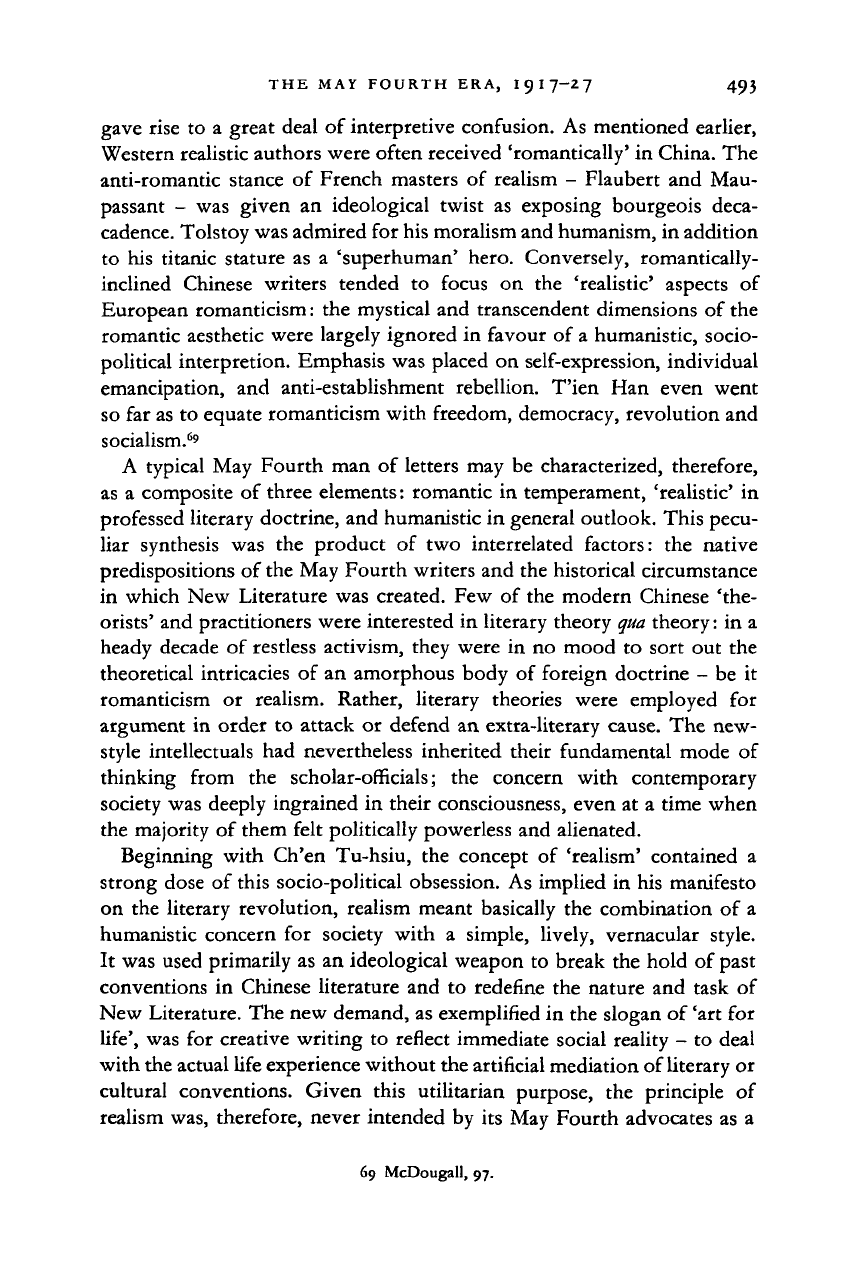
THE MAY
FOURTH
ERA, I 9 I 7-2 7 493
gave rise to a great deal of interpretive confusion. As mentioned earlier,
Western realistic authors were often received 'romantically' in China. The
anti-romantic stance of French masters of realism - Flaubert and Mau-
passant - was given an ideological twist as exposing bourgeois deca-
cadence. Tolstoy was admired for his moralism and humanism, in addition
to his titanic stature as a 'superhuman' hero. Conversely, romantically-
inclined Chinese writers tended to focus on the 'realistic' aspects of
European romanticism: the mystical and transcendent dimensions of the
romantic aesthetic were largely ignored in favour of a humanistic, socio-
political interpretion. Emphasis was placed on self-expression, individual
emancipation, and anti-establishment rebellion. T'ien Han even went
so far as to equate romanticism with freedom, democracy, revolution and
socialism.
6
'
A typical May Fourth man of letters may be characterized, therefore,
as a composite of three elements: romantic in temperament, 'realistic' in
professed literary doctrine, and humanistic in general outlook. This pecu-
liar synthesis was the product of two interrelated factors: the native
predispositions of the May Fourth writers and the historical circumstance
in which New Literature was created. Few of the modern Chinese 'the-
orists'
and practitioners were interested in literary theory
qua
theory: in a
heady decade of restless activism, they were in no mood to sort out the
theoretical intricacies of an amorphous body of foreign doctrine - be it
romanticism or realism. Rather, literary theories were employed for
argument in order to attack or defend an extra-literary cause. The new-
style intellectuals had nevertheless inherited their fundamental mode of
thinking from the scholar-officials; the concern with contemporary
society was deeply ingrained in their consciousness, even at a time when
the majority of them felt politically powerless and alienated.
Beginning with Ch'en Tu-hsiu, the concept of 'realism' contained a
strong dose of this socio-political obsession. As implied in his manifesto
on the literary revolution, realism meant basically the combination of a
humanistic concern for society with a simple, lively, vernacular style.
It was used primarily as an ideological weapon to break the hold of past
conventions in Chinese literature and to redefine the nature and task of
New Literature. The new demand, as exemplified in the slogan of 'art for
life',
was for creative writing to reflect immediate social reality - to deal
with the actual life experience without the artificial mediation of literary or
cultural conventions. Given this utilitarian purpose, the principle of
realism was, therefore, never intended by its May Fourth advocates as a
69 McDougall, 97.
Cambridge Histories Online © Cambridge University Press, 2008
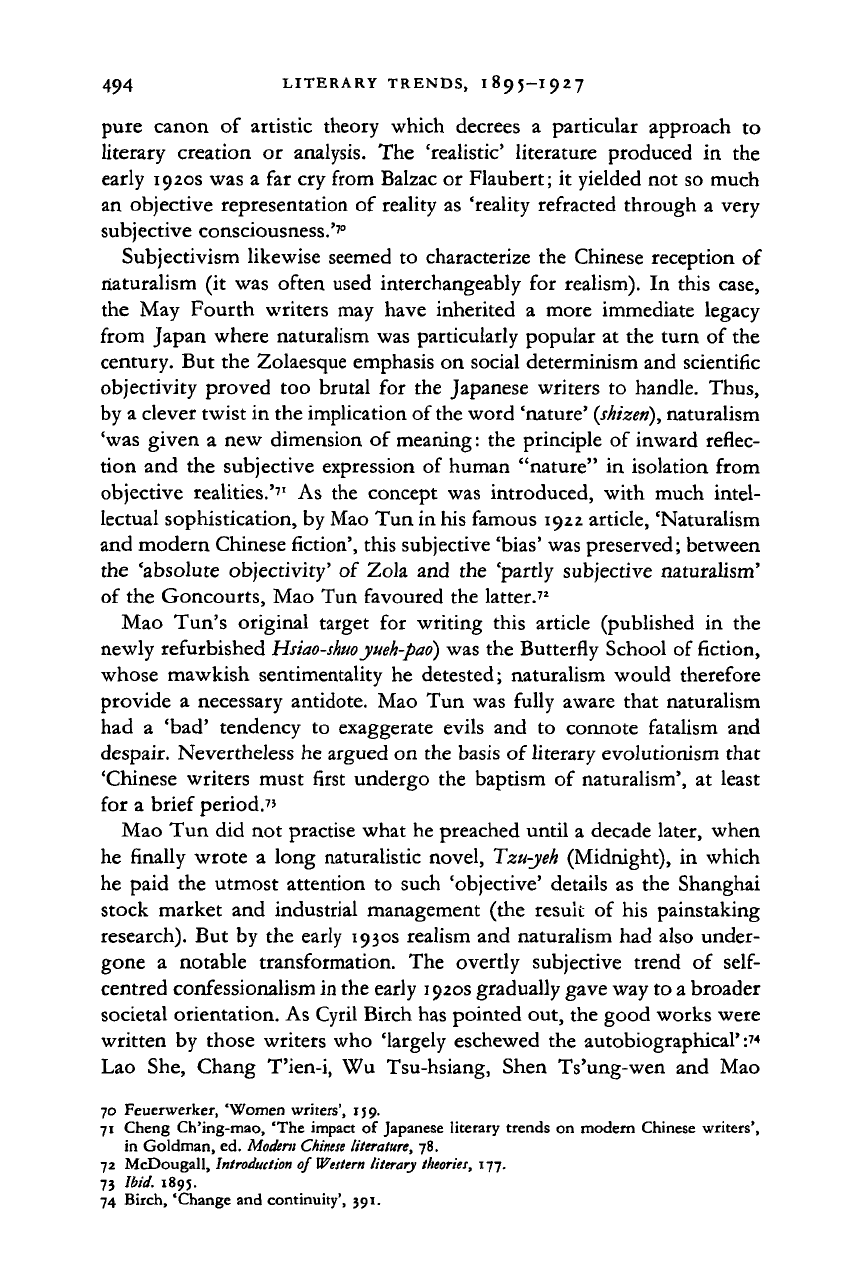
494 LITERARY TRENDS, 1895-1927
pure canon
of
artistic theory which decrees
a
particular approach
to
literary creation
or
analysis.
The
'realistic' literature produced
in the
early 1920s was
a
far cry from Balzac or Flaubert;
it
yielded not so much
an objective representation
of
reality as 'reality refracted through
a
very
subjective consciousness.'
70
Subjectivism likewise seemed
to
characterize the Chinese reception of
naturalism
(it
was often used interchangeably
for
realism).
In
this case,
the May Fourth writers may have inherited
a
more immediate legacy
from Japan where naturalism was particularly popular at the turn of the
century. But the Zolaesque emphasis on social determinism and scientific
objectivity proved too brutal
for
the Japanese writers
to
handle. Thus,
by a clever twist in the implication of
the
word 'nature'
{shizeri),
naturalism
'was given
a
new dimension
of
meaning: the principle
of
inward reflec-
tion and the subjective expression
of
human "nature"
in
isolation from
objective realities.'
71
As
the concept was introduced, with much intel-
lectual sophistication, by Mao Tun in his famous 1922 article, 'Naturalism
and modern Chinese fiction', this subjective 'bias' was preserved; between
the 'absolute objectivity'
of
Zola and the 'partly subjective naturalism'
of the Goncourts, Mao Tun favoured the latter.
72
Mao Tun's original target
for
writing this article (published
in the
newly refurbished Hsiao-shuo
jueh-pad)
was the Butterfly School
of
fiction,
whose mawkish sentimentality
he
detested; naturalism would therefore
provide
a
necessary antidote. Mao Tun was fully aware that naturalism
had
a
'bad' tendency
to
exaggerate evils and
to
connote fatalism and
despair. Nevertheless he argued on the basis of literary evolutionism that
'Chinese writers must first undergo the baptism
of
naturalism',
at
least
for
a
brief period.
7
'
Mao Tun did not practise what he preached until
a
decade later, when
he finally wrote
a
long naturalistic novel, Tzu-jek (Midnight),
in
which
he paid the utmost attention
to
such 'objective' details
as
the Shanghai
stock market and industrial management (the result
of
his painstaking
research). But by the early 1930s realism and naturalism had also under-
gone
a
notable transformation.
The
overtly subjective trend
of
self-
centred confessionalism in the early 1920s gradually gave way to a broader
societal orientation. As Cyril Birch has pointed out, the good works were
written
by
those writers who 'largely eschewed the autobiographical':
74
Lao She, Chang T'ien-i,
Wu
Tsu-hsiang, Shen Ts'ung-wen
and
Mao
70 Feuerwerker, 'Women writers', 159.
71 Cheng Ch'ing-mao, 'The impact
of
Japanese literary trends on modern Chinese writers',
in Goldman, ed.
Modern Chinese
literature, 78.
72 McDougall,
Introduction
of
Western
literary
tlieories,
177.
73
Ibid.
1895.
74 Birch, 'Change and continuity', 391.
Cambridge Histories Online © Cambridge University Press, 2008
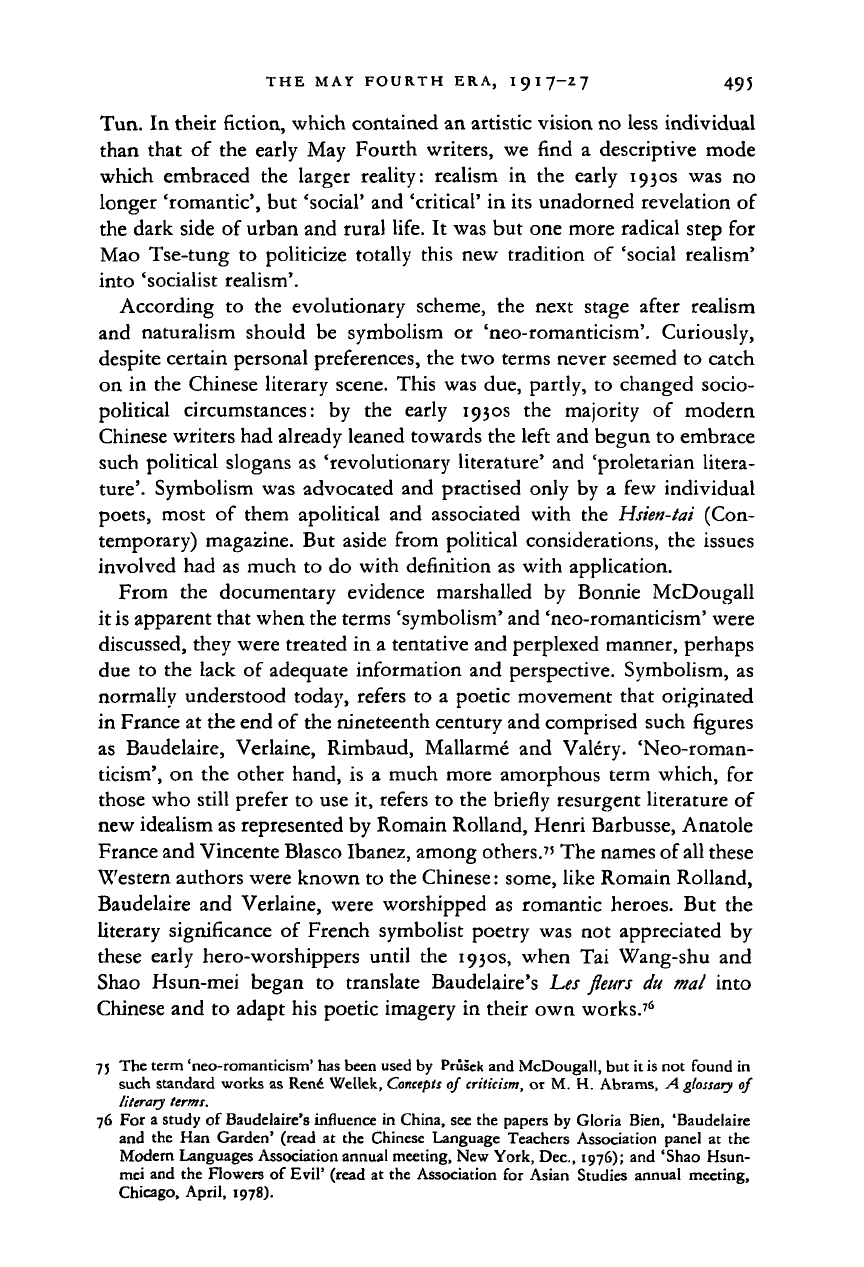
THE MAY FOURTH ERA, I 9 I 7-2 7 495
Tun. In their fiction, which contained an artistic vision no less individual
than that of the early May Fourth writers, we find a descriptive mode
which embraced the larger reality: realism in the early 1930s was no
longer 'romantic', but 'social' and 'critical' in its unadorned revelation of
the dark side of urban and rural life. It was but one more radical step for
Mao Tse-tung to politicize totally this new tradition of 'social realism'
into 'socialist realism'.
According to the evolutionary scheme, the next stage after realism
and naturalism should be symbolism or 'neo-romanticism'. Curiously,
despite certain personal preferences, the two terms never seemed to catch
on in the Chinese literary scene. This was due, partly, to changed socio-
political circumstances: by the early 1930s the majority of modern
Chinese writers had already leaned towards the left and begun to embrace
such political slogans as 'revolutionary literature' and 'proletarian litera-
ture'.
Symbolism was advocated and practised only by a few individual
poets,
most of them apolitical and associated with the Hsien-tai (Con-
temporary) magazine. But aside from political considerations, the issues
involved had as much to do with definition as with application.
From the documentary evidence marshalled by Bonnie McDougall
it
is
apparent that when the terms 'symbolism' and 'neo-romanticism' were
discussed, they were treated in a tentative and perplexed manner, perhaps
due to the lack of adequate information and perspective. Symbolism, as
normally understood today, refers to a poetic movement that originated
in France at the end of the nineteenth century and comprised such figures
as Baudelaire, Verlaine, Rimbaud, Mallarme and Valery. 'Neo-roman-
ticism', on the other hand, is a much more amorphous term which, for
those who still prefer to use it, refers to the briefly resurgent literature of
new idealism as represented by Romain Rolland, Henri Barbusse, Anatole
France and Vincente Blasco Ibanez, among others.
75
The names of
all
these
Western authors were known to the Chinese: some, like Romain Rolland,
Baudelaire and Verlaine, were worshipped as romantic heroes. But the
literary significance of French symbolist poetry was not appreciated by
these early hero-worshippers until the 1930s, when Tai Wang-shu and
Shao Hsun-mei began to translate Baudelaire's Les fleurs du mal into
Chinese and to adapt his poetic imagery in their own works.
76
75
The term
'neo-romanticism'
has been used by Prusek and McDougall, but it is not found in
such
standard works as Rene Wellek,
Concepts
of
criticism,
or M. H.
Abrams,
A
glossary
of
literary
terms.
76
For a study of
Baudelaire's
influence in
China,
see the papers by Gloria
Bien,
'Baudelaire
and
the Han
Garden'
(read at the Chinese Language Teachers Association panel at the
Modern
Languages Association annual
meeting,
New York, Dec,
1976);
and 'Shao
Hsun-
mei
and the Flowers of
Evil'
(read at the Association for Asian Studies annual
meeting,
Chicago,
April,
1978).
Cambridge Histories Online © Cambridge University Press, 2008
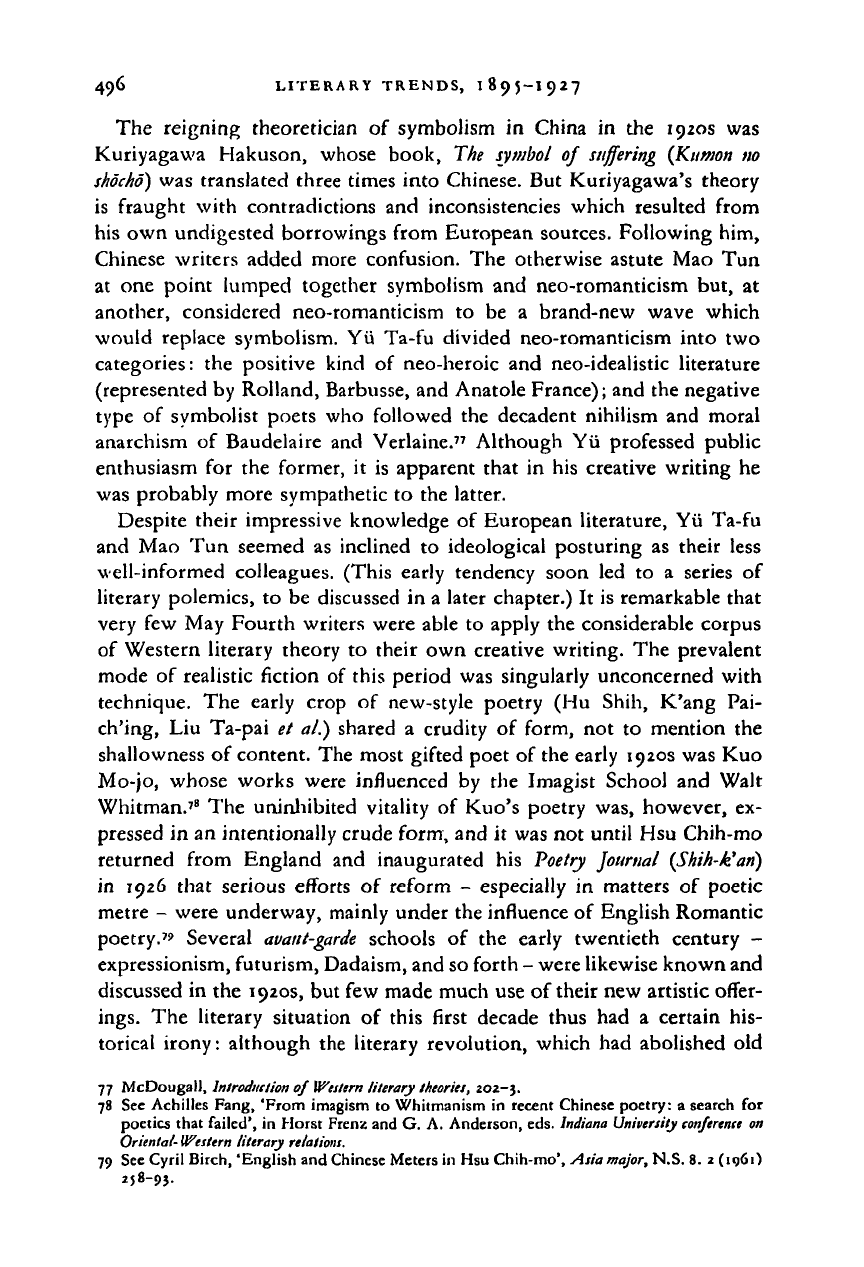
496 LITERARY TRENDS, 1895-I927
The reigning theoretician
of
symbolism
in
China
in
the 1920s was
Kuriyagawa Hakuson, whose book, The symbol
of
suffering [Kumon
no
shocho)
was translated three times into Chinese. But Kuriyagawa's theory
is fraught with contradictions and inconsistencies which resulted from
his own undigested borrowings from European sources. Following him,
Chinese writers added more confusion. The otherwise astute Mao Tun
at one point lumped together symbolism and neo-romanticism but,
at
another, considered neo-romanticism
to be a
brand-new wave which
would replace symbolism. Yu Ta-fu divided neo-romanticism into two
categories: the positive kind
of
neo-heroic and neo-idealistic literature
(represented by Rolland, Barbusse, and Anatole France); and the negative
type
of
symbolist poets who followed the decadent nihilism and moral
anarchism
of
Baudelaire and Verlaine." Although Yii professed public
enthusiasm for the former,
it
is apparent that
in
his creative writing he
was probably more sympathetic to the latter.
Despite their impressive knowledge
of
European literature, Yii Ta-fu
and Mao Tun seemed as inclined
to
ideological posturing as their less
well-informed colleagues. (This early tendency soon led
to a
series
of
literary polemics, to be discussed in a later chapter.) It is remarkable that
very few May Fourth writers were able to apply the considerable corpus
of Western literary theory to their own creative writing. The prevalent
mode of realistic fiction of this period was singularly unconcerned with
technique. The early crop
of
new-style poetry (Hu Shih, K'ang Pai-
ch'ing, Liu Ta-pai et al.) shared
a
crudity
of
form, not
to
mention the
shallowness of content. The most gifted poet of the early 1920s was Kuo
Mo-jo,
whose works were influenced by the Imagist School and Walt
Whitman.'
8
The uninhibited vitality
of
Kuo's poetry was, however, ex-
pressed in an intentionally crude form, and it was not until Hsu Chih-mo
returned from England and inaugurated
his
Poetry journal (Shih-k'ari)
in 1926 that serious efforts
of
reform
-
especially
in
matters
of
poetic
metre
-
were underway, mainly under the influence of English Romantic
poetry." Several
avant-garde
schools
of
the early twentieth century
-
expressionism, futurism, Dadaism, and so forth
-
were likewise known and
discussed in the 1920s, but few made much use of their new artistic offer-
ings.
The literary situation
of
this first decade thus had
a
certain his-
torical irony: although the literary revolution, which had abolished old
77 McDougall,
Introduction
of
Western
literary
theories,
202-}.
78 See Achilles Fang, 'From imagism to Whitmanism
in
recent Chinese poetry:
a
search
for
poetics that failed', in Horst Frenz and G. A. Anderson, eds. Indiana University
conference
on
Oriental-Western literary
relations.
79 See Cyril Birch, 'English and Chinese Meters in Hsu Chih-mo', Asia major, N.S. 8. 2
(IQ6I)
258-9$.
Cambridge Histories Online © Cambridge University Press, 2008
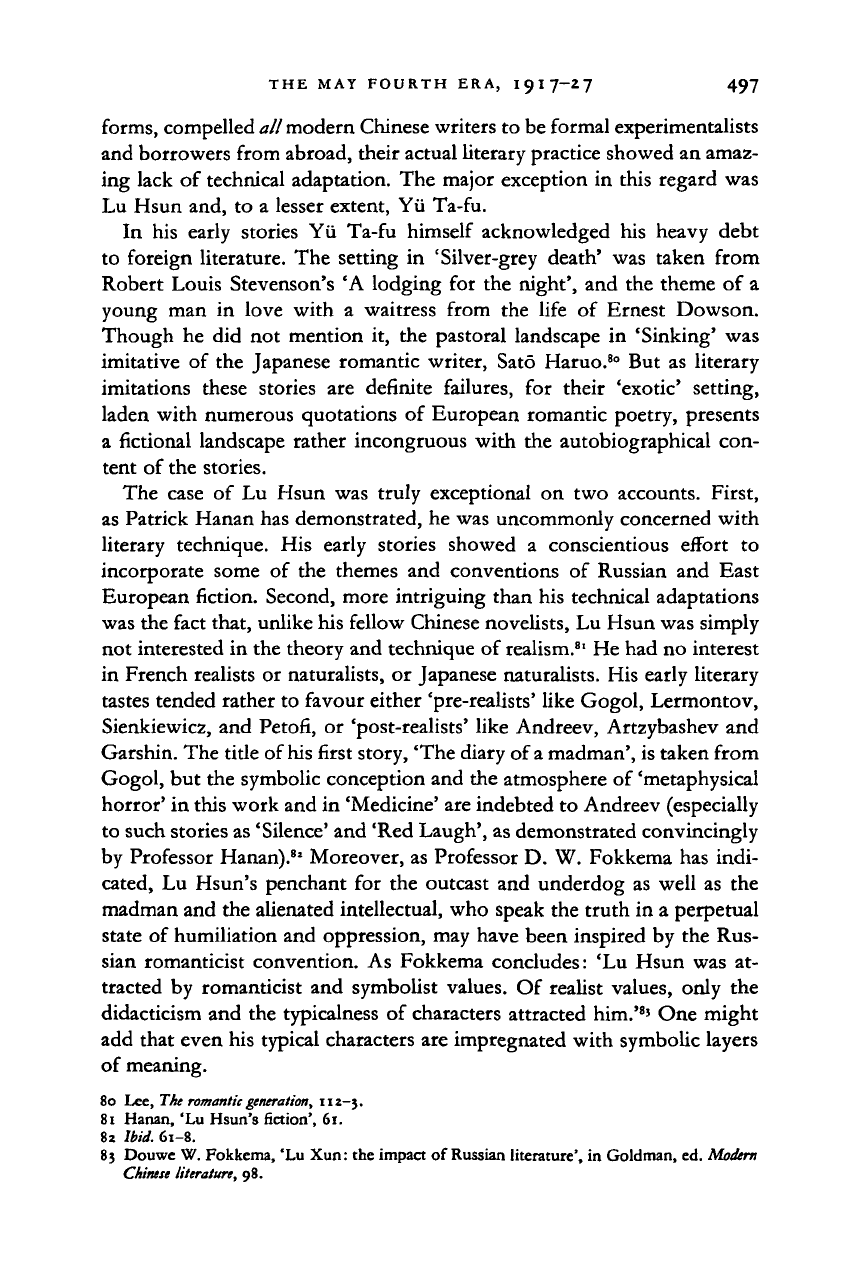
THE MAY FOURTH ERA, I 9 I 7-2 7 497
forms,
compelled all modern Chinese writers to be formal experimentalists
and borrowers from abroad, their actual literary practice showed an amaz-
ing lack of technical adaptation. The major exception in this regard was
Lu Hsun and, to a lesser extent, Yii Ta-fu.
In his early stories Yii Ta-fu himself acknowledged his heavy debt
to foreign literature. The setting in 'Silver-grey death' was taken from
Robert Louis Stevenson's 'A lodging for the night', and the theme of a
young man in love with a waitress from the life of Ernest Dowson.
Though he did not mention it, the pastoral landscape in 'Sinking' was
imitative of the Japanese romantic writer, Sato Haruo.
80
But as literary
imitations these stories are definite failures, for their 'exotic' setting,
laden with numerous quotations of European romantic poetry, presents
a fictional landscape rather incongruous with the autobiographical con-
tent of the stories.
The case of Lu Hsun was truly exceptional on two accounts. First,
as Patrick Hanan has demonstrated, he was uncommonly concerned with
literary technique. His early stories showed a conscientious effort to
incorporate some of the themes and conventions of Russian and East
European fiction. Second, more intriguing than his technical adaptations
was the fact that, unlike his fellow Chinese novelists, Lu Hsun was simply
not interested in the theory and technique of realism.
81
He had no interest
in French realists or naturalists, or Japanese naturalists. His early literary
tastes tended rather to favour either 'pre-realists' like Gogol, Lermontov,
Sienkiewicz, and Petofi, or 'post-realists' like Andreev, Artzybashev and
Garshin. The title of
his
first story, 'The diary of
a
madman', is taken from
Gogol, but the symbolic conception and the atmosphere of 'metaphysical
horror' in this work and in 'Medicine' are indebted to Andreev (especially
to such stories as 'Silence' and 'Red Laugh', as demonstrated convincingly
by Professor Hanan).
8
* Moreover, as Professor D. W. Fokkema has indi-
cated, Lu Hsun's penchant for the outcast and underdog as well as the
madman and the alienated intellectual, who speak the truth in a perpetual
state of humiliation and oppression, may have been inspired by the Rus-
sian romanticist convention. As Fokkema concludes: 'Lu Hsun was at-
tracted by romanticist and symbolist values. Of realist values, only the
didacticism and the typicalness of characters attracted him.'
8
' One might
add that even his typical characters are impregnated with symbolic layers
of meaning.
80 Lee,
The romantic
generation,
112-3.
81 Hanan, 'Lu Hsun's fiction', 61.
82
Ibid.
61-8.
83 Douwe W. Fokkema, 'Lu Xun: the impact of Russian literature', in Goldman, ed. Modern
Chinese literature, 98.
Cambridge Histories Online © Cambridge University Press, 2008

498 LITERARY TRENDS, 1895-1927
The intriguing implication of
this
foreign literary impact on Lu Hsun is
that almost alone in modern Chinese fiction, Lu Hsun had 'progressed'
to the symbolist stage, though none of his contemporaries (with the
exception of his brother, Chou Tso-jen) acknowledged it. This symbolist
tendency is particularly noteworthy in his collection of prose poetry,
Yeh-ts'ao (Wild grass), written between 1924 and 1926. Compared by
Prusek to Baudelaire's
Petits poemes en prose
in mood and tone, these 23
pieces evoke a nightmarish world suffused with such darkly glowing and
oddly lyrical images as dilapidated tombstones, frozen flames of fire,
ghost-infested 'hells', a beggar-like traveller journeying to the grave, a
tormented Jesus in the last throes of the crucifixion, and a javelin-throw-
ing fighter combating, single-handed, the throng of 'nothingness'.
84
As a symbolic representation of Lu Hsun's private psyche and a meta-
phorical record of his search for meaning, the collection is the most
difficult of
all
his works and is, consequently, the least understood among
Chinese readers. It seems as if in his prose poetry Lu Hsun had gone
beyond the familiar sensibilities of his generation to the threshold of
Western modernistic literature.
However, references to Nietzsche, Kierkegaard and Christian mar-
tyrdom notwithstanding, the basic ethos which informs this collection is
nevertheless qualitatively different from that in Western modernistic litera-
ture.
Rather than revealing the 'universal' human condition of absurdity -
of the individual man trapped in the impasse of meaninglessness - this
most 'surrealistic' of Lu Hsun's works still carries a humanistic compul-
sion to find meaning. While burdened with many paradoxes - of life and
death, past and future, hope and despair - Lu Hsun's wandering spirit
is not entirely lost in nihilism. On the contrary, several pieces of the
collection seem to suggest that there is, indeed, a way out of the impasse:
the frozen 'dead fire' finally opts to fling itself out of the icy valley, and
the weary traveller, pausing on the road of life, finally decides to walk
on. Although Lu Hsun never specifies it clearly, the message at the end
seems to point to the possibility that an ethical act of human will can
still impose a certain meaning on this existential condition of meaning-
lessness. Accordingly, Lu Hsun's artistic and 'metaphysical' flirtation
with Western symbolism and modernism in this collection has not led
him to Eliot's 'wasteland' or to the absurd world of Beckett or Ionesco.
Instead, it compels him to return to humanity. At the end of a piece
describing the last moments of Christ's crucifixion, Lu Hsun enters the
closing comment: 'God has forsaken him, and so he is the son of man
after all.'
84 Lu Hsun,
Yeh-ts'ao
(Wild grass).
Cambridge Histories Online © Cambridge University Press, 2008
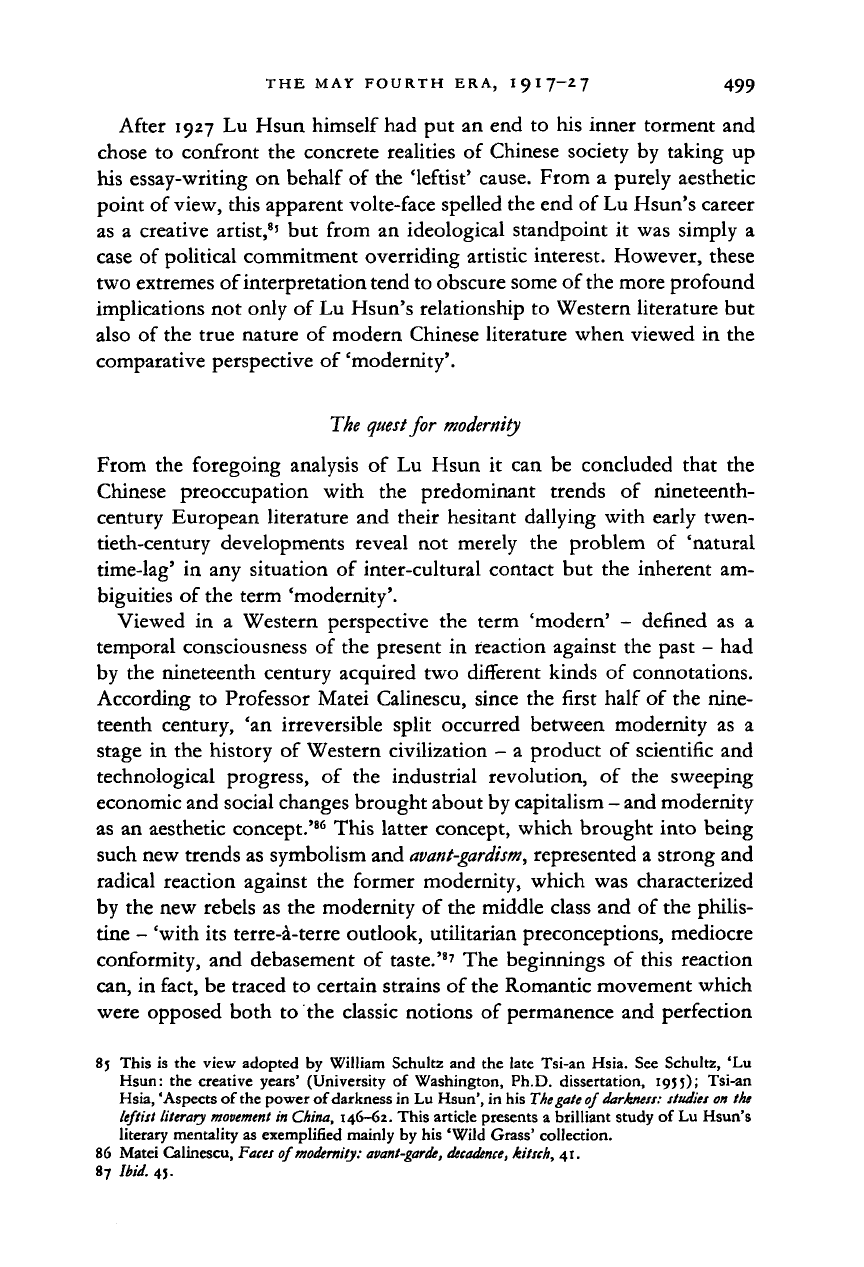
THE MAY FOURTH ERA, I 9 I 7-2 7 499
After 1927 Lu Hsun himself had put an end to his inner torment and
chose to confront the concrete realities of Chinese society by taking up
his essay-writing on behalf of the 'leftist' cause. From a purely aesthetic
point of view, this apparent volte-face spelled the end of Lu Hsun's career
as a creative artist,
8
' but from an ideological standpoint it was simply a
case of political commitment overriding artistic interest. However, these
two extremes of interpretation tend to obscure some of the more profound
implications not only of Lu Hsun's relationship to Western literature but
also of the true nature of modern Chinese literature when viewed in the
comparative perspective of 'modernity'.
The quest for modernity
From the foregoing analysis of Lu Hsun it can be concluded that the
Chinese preoccupation with the predominant trends of nineteenth-
century European literature and their hesitant dallying with early twen-
tieth-century developments reveal not merely the problem of 'natural
time-lag' in any situation of inter-cultural contact but the inherent am-
biguities of the term 'modernity'.
Viewed in a Western perspective the term 'modern' - denned as a
temporal consciousness of the present in reaction against the past - had
by the nineteenth century acquired two different kinds of connotations.
According to Professor Matei Calinescu, since the first half of the nine-
teenth century, 'an irreversible split occurred between modernity as a
stage in the history of Western civilization - a product of scientific and
technological progress, of the industrial revolution, of the sweeping
economic and social changes brought about by capitalism - and modernity
as an aesthetic concept.'
86
This latter concept, which brought into being
such new trends as symbolism and
avant-gardism,
represented a strong and
radical reaction against the former modernity, which was characterized
by the new rebels as the modernity of the middle class and of the philis-
tine - 'with its terre-a-terre outlook, utilitarian preconceptions, mediocre
conformity, and debasement of taste.'
87
The beginnings of this reaction
can, in fact, be traced to certain strains of the Romantic movement which
were opposed both to the classic notions of permanence and perfection
85 This is the view adopted by William Schultz and the late Tsi-an Hsia. See Schultz, 'Lu
Hsun: the creative years' (University of Washington, Ph.D. dissertation, 1955); Tsi-an
Hsia,'Aspects of the power of darkness in Lu Hsun', in his The gate ofdarkness:
studies
on
the
leftist literary
movement
in
China,
146-62. This article presents a brilliant study of Lu Hsun's
literary mentality as exemplified mainly by his 'Wild Grass' collection.
86
Matei
Calinescu,
Faces
of
modernity:
avant-garde,
decadence,
kitsch,
41.
87
Ibid.
45.
Cambridge Histories Online © Cambridge University Press, 2008
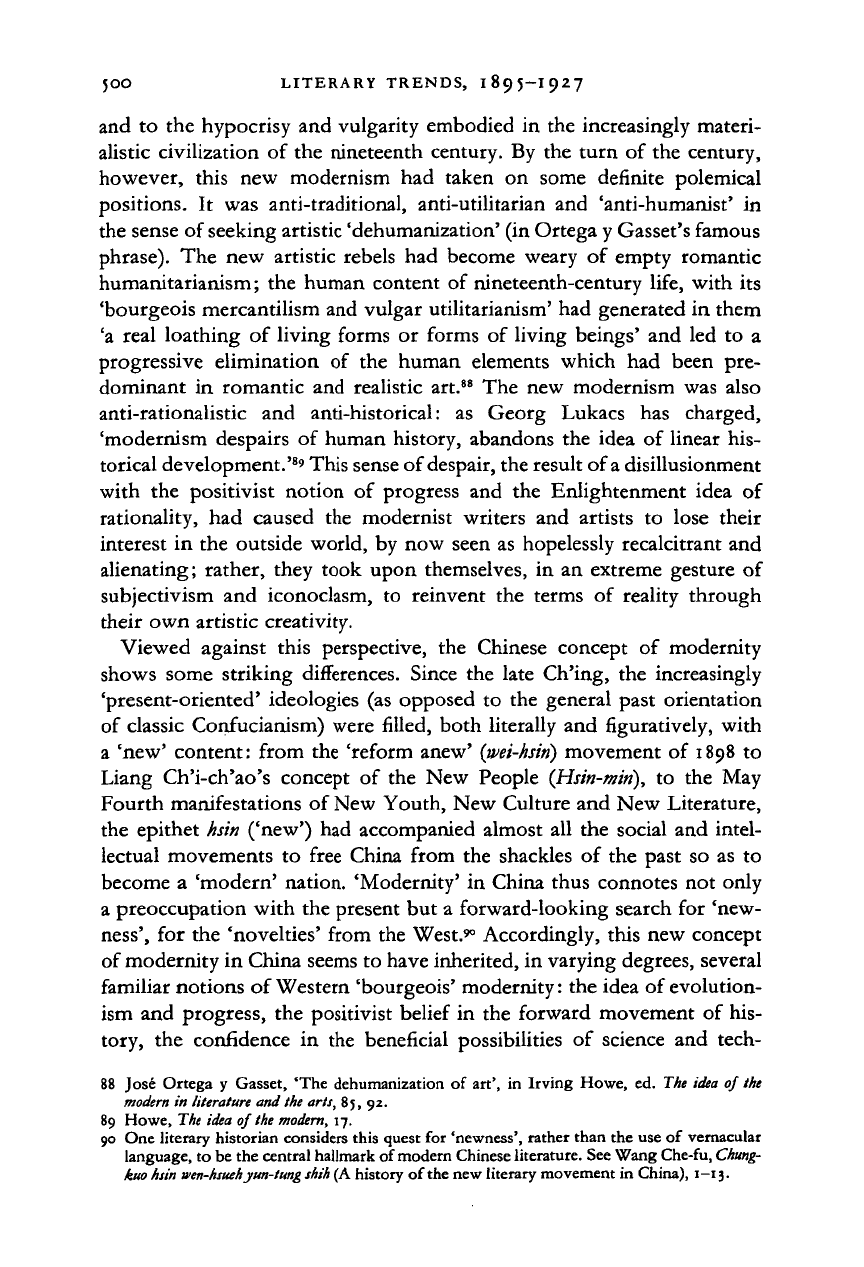
JOO
LITERARY TRENDS, 1895-I927
and
to
the hypocrisy and vulgarity embodied
in
the increasingly materi-
alistic civilization
of
the nineteenth century. By the turn
of
the century,
however, this
new
modernism
had
taken
on
some definite polemical
positions.
It
was anti-traditional, anti-utilitarian and 'anti-humanist'
in
the sense of seeking artistic 'dehumanization' (in Ortega y Gasset's famous
phrase). The new artistic rebels had become weary
of
empty romantic
humanitarianism; the human content
of
nineteenth-century life, with its
'bourgeois mercantilism and vulgar utilitarianism' had generated in them
'a real loathing
of
living forms
or
forms
of
living beings' and led
to a
progressive elimination
of the
human elements which
had
been pre-
dominant
in
romantic and realistic art.
88
The new modernism was also
anti-rationalistic
and
anti-historical:
as
Georg Lukacs
has
charged,
'modernism despairs
of
human history, abandons the idea
of
linear his-
torical development.'
8
' This sense of despair, the result of a disillusionment
with
the
positivist notion
of
progress and the Enlightenment idea
of
rationality,
had
caused
the
modernist writers and artists
to
lose their
interest
in
the outside world, by now seen as hopelessly recalcitrant and
alienating; rather, they took upon themselves,
in
an extreme gesture of
subjectivism and iconoclasm,
to
reinvent
the
terms
of
reality through
their own artistic creativity.
Viewed against this perspective,
the
Chinese concept
of
modernity
shows some striking differences. Since the late Ch'ing, the increasingly
'present-oriented' ideologies (as opposed
to
the general past orientation
of classic Confucianism) were filled, both literally and figuratively, with
a 'new' content: from the 'reform anew'
(wei-hsiri)
movement
of
1898
to
Liang Ch'i-ch'ao's concept
of
the New People
(Hsin-miri),
to
the May
Fourth manifestations of New Youth, New Culture and New Literature,
the epithet hsin ('new') had accompanied almost all the social and intel-
lectual movements
to
free China from the shackles
of
the past so as
to
become
a
'modern' nation. 'Modernity' in China thus connotes not only
a preoccupation with the present but a forward-looking search for 'new-
ness',
for the 'novelties' from the West.
90
Accordingly, this new concept
of modernity in China seems to have inherited, in varying degrees, several
familiar notions of Western 'bourgeois' modernity: the idea of evolution-
ism and progress, the positivist belief in the forward movement
of
his-
tory,
the
confidence
in
the beneficial possibilities
of
science and tech-
88 Jose Ortega
y
Gasset, 'The dehumanization
of
art',
in
Irving Howe, ed. The idea of
the
modern
in literature and
the
arts, 85, 92.
89 Howe, The idea of
the
modern,
17.
90 One literary historian considers this quest for 'newness', rather than the use
of
vernacular
language, to be the central hallmark of modern Chinese literature. See Wang Che-fu,
Chung-
kuo
hsin
aen-hsueh
yun-tung shih
(A history of the new literary movement in China), 1—13.
Cambridge Histories Online © Cambridge University Press, 2008
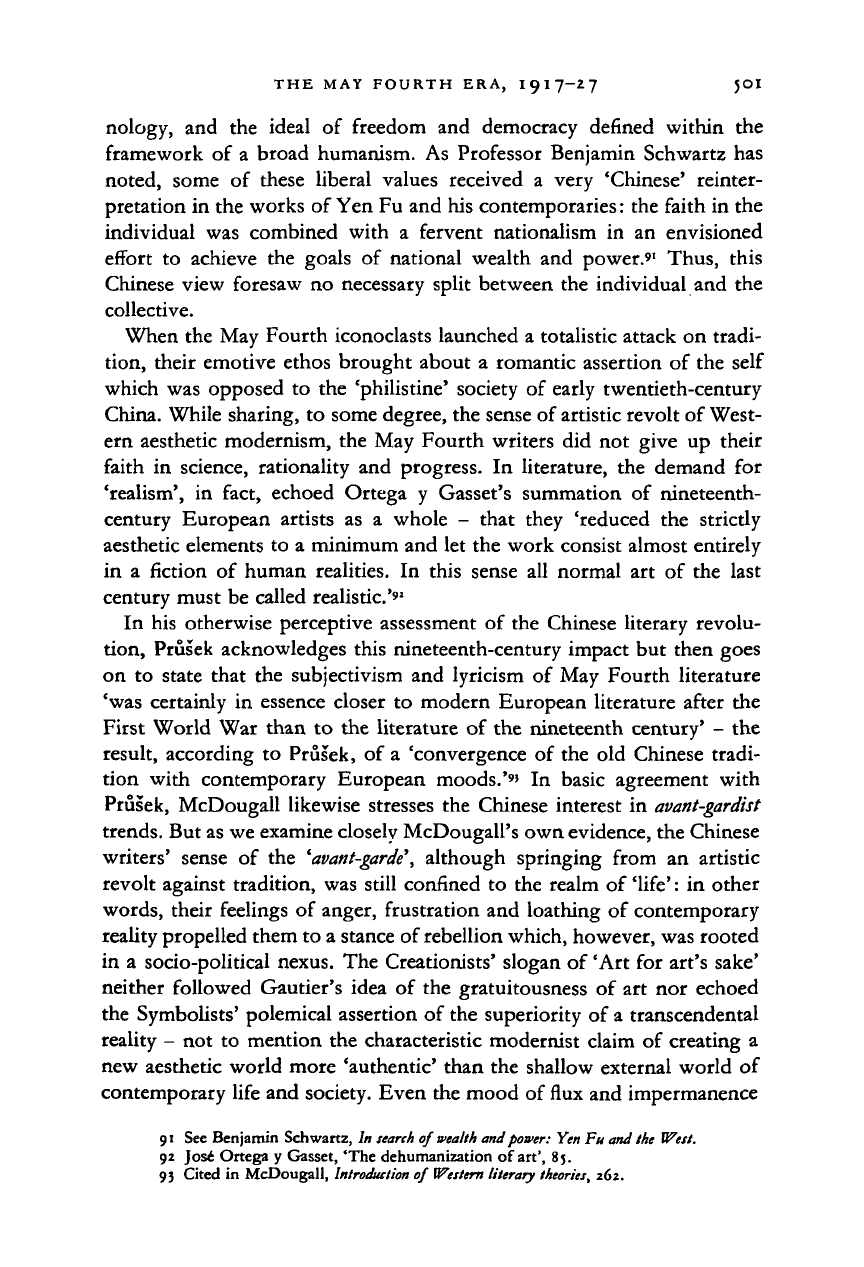
THE MAY FOURTH ERA, I 9
1
7-2 7 50I
nology, and the ideal of freedom and democracy defined within the
framework of a broad humanism. As Professor Benjamin Schwartz has
noted, some of these liberal values received a very 'Chinese' reinter-
pretation in the works of Yen Fu and his contemporaries: the faith in the
individual was combined with a fervent nationalism in an envisioned
effort to achieve the goals of national wealth and power.
9
' Thus, this
Chinese view foresaw no necessary split between the individual and the
collective.
When the May Fourth iconoclasts launched a totalistic attack on tradi-
tion, their emotive ethos brought about a romantic assertion of the self
which was opposed to the 'philistine' society of early twentieth-century
China. While sharing, to some degree, the sense of artistic revolt of West-
ern aesthetic modernism, the May Fourth writers did not give up their
faith in science, rationality and progress. In literature, the demand for
'realism', in fact, echoed Ortega y Gasset's summation of nineteenth-
century European artists as a whole - that they 'reduced the strictly
aesthetic elements to a minimum and let the work consist almost entirely
in a fiction of human realities. In this sense all normal art of the last
century must be called realistic.'*
2
In his otherwise perceptive assessment of the Chinese literary revolu-
tion, Prusek acknowledges this nineteenth-century impact but then goes
on to state that the subjectivism and lyricism of May Fourth literature
'was certainly in essence closer to modern European literature after the
First World War than to the literature of the nineteenth century' - the
result, according to Prusek, of a 'convergence of the old Chinese tradi-
tion with contemporary European moods.'" In basic agreement with
Prusek, McDougall likewise stresses the Chinese interest in
avant-gardist
trends. But as we examine closely McDougall's own evidence, the Chinese
writers' sense of the
'avant-garde",
although springing from an artistic
revolt against tradition, was still confined to the realm of 'life': in other
words, their feelings of anger, frustration and loathing of contemporary
reality propelled them to a stance of rebellion which, however, was rooted
in a socio-political nexus. The Creationists' slogan of 'Art for art's sake'
neither followed Gautier's idea of the gratuitousness of art nor echoed
the Symbolists' polemical assertion of the superiority of a transcendental
reality - not to mention the characteristic modernist claim of creating a
new aesthetic world more 'authentic' than the shallow external world of
contemporary life and society. Even the mood of flux and impermanence
91 See Benjamin Schwartz, In
search
of
wealth
and power:
Yen
Fu and
the
West.
92 Jose Ortega y Gasset, "The dehumanization of art', 85.
93 Cited in McDougall,
Introduction
of
Western
literary
theories,
262.
Cambridge Histories Online © Cambridge University Press, 2008
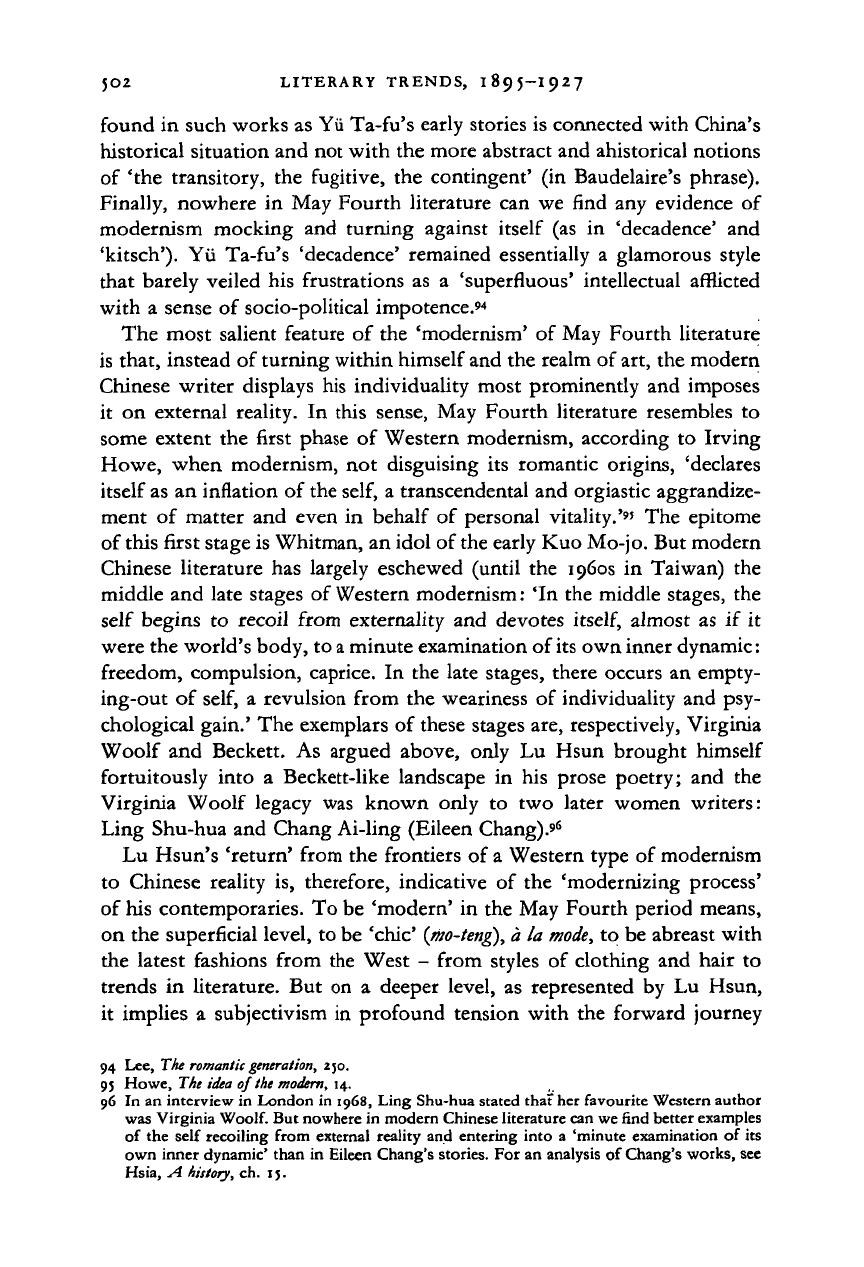
JO2
LITERARY
TRENDS,
1895-I927
found in such works as Yii Ta-fu's early stories is connected with China's
historical situation and not with the more abstract and ahistorical notions
of 'the transitory, the fugitive, the contingent' (in Baudelaire's phrase).
Finally, nowhere in May Fourth literature can we find any evidence of
modernism mocking and turning against itself (as in 'decadence' and
'kitsch').
Yii Ta-fu's 'decadence' remained essentially a glamorous style
that barely veiled his frustrations as a 'superfluous' intellectual afflicted
with a sense of socio-political impotence.'
4
The most salient feature of the 'modernism' of May Fourth literature
is that, instead of turning within himself and the realm of art, the modern
Chinese writer displays his individuality most prominently and imposes
it on external reality. In this sense, May Fourth literature resembles to
some extent the first phase of Western modernism, according to Irving
Howe, when modernism, not disguising its romantic origins, 'declares
itself as an inflation of the
self,
a transcendental and orgiastic aggrandize-
ment of matter and even in behalf of personal vitality.'" The epitome
of this first stage is Whitman, an idol of the early Kuo Mo-jo. But modern
Chinese literature has largely eschewed (until the 1960s in Taiwan) the
middle and late stages of Western modernism: 'In the middle stages, the
self begins to recoil from externality and devotes
itself,
almost as if it
were the world's body, to
a
minute examination of
its
own inner dynamic:
freedom, compulsion, caprice. In the late stages, there occurs an empty-
ing-out of
self,
a revulsion from the weariness of individuality and psy-
chological gain.' The exemplars of these stages are, respectively, Virginia
Woolf and Beckett. As argued above, only Lu Hsun brought himself
fortuitously into a Beckett-like landscape in his prose poetry; and the
Virginia Woolf legacy was known only to two later women writers:
Ling Shu-hua and Chang Ai-ling (Eileen Chang).«
s
Lu Hsun's 'return' from the frontiers of a Western type of modernism
to Chinese reality is, therefore, indicative of the 'modernizing process'
of his contemporaries. To be 'modern' in the May Fourth period means,
on the superficial level, to be 'chic'
(mo-teng),
a la
mode,
to be abreast with
the latest fashions from the West - from styles of clothing and hair to
trends in literature. But on a deeper level, as represented by Lu Hsun,
it implies a subjectivism in profound tension with the forward journey
94 Lee, The
romantic
generation,
250.
95 Howe, The
idea
of
the
modern,
14.
96 In an interview in London in 1968, Ling Shu-hua stated that her favourite Western author
was Virginia
Woolf.
But nowhere in modern Chinese literature can we find better examples
of the self recoiling from external reality and entering into a 'minute examination of its
own inner dynamic' than in Eileen Chang's stories. For an analysis of Chang's works, see
Hsia, A history, ch. 15.
Cambridge Histories Online © Cambridge University Press, 2008
